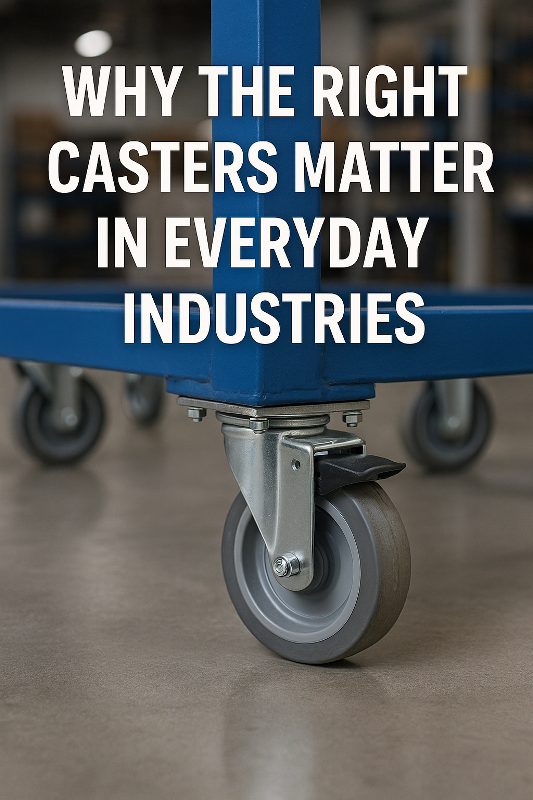Why the Right Casters Matter in Everyday Industries

In a world where seamless movement is often taken for granted, casters stand out as the unheralded heroes of everyday mobility. Whether it’s a hospital gurney navigating sterile hallways or a warehouse trolley stacked high with goods, these small components play a pivotal role. Key among these is plate casters, designed to withstand significant loads and facilitate smooth motion across various surfaces with minimal effort. The thorough engineering behind these devices ensures they can gracefully support heavy equipment, minimizing the risk of damage or disruption to critical operations. Casters’ evolution mirrors other mechanical innovations: adapting to challenges, adopting new materials, and enhancing functionality. Yet, despite their widespread use, the importance of selecting the right caster is often underestimated. It’s time to bring them into the spotlight and acknowledge their crucial contribution to efficiency and safety in diverse settings, from high-powered laboratories to bustling commercial kitchens.
The Science Behind Casters
Casters operate on simple yet effective principles of physics. Their design allows for efficient load distribution, minimizing friction and enhancing ease of movement. This is particularly evident in objects with a high weight-to-wheel ratio. For instance, understanding how casters distribute weight can drastically reduce effort and prevent surface wear. The rolling action of a caster involves dynamic interactions between wheel material and the flooring surface, which generates less resistance than sliding or dragging an object. Material science also plays a significant role. From rubber to polyurethane, the composition of caster wheels determines their durability and suitability for different environments. Softer materials provide better traction on smooth floors, while harder materials can support heavier loads without deformation. In specific settings, such as warehouses with slick concrete floors, anti-static or electrically conductive casters are essential to prevent sparking and safeguard sensitive electronic equipment. The choice must align with the specific needs of the task at hand, and it is imperative to consider the interaction between caster materials and the environments they will traverse.
Choosing the Right Caster for the Job
Selecting the appropriate caster is more than choosing the right size or style. Load capacity, wheel type, and environmental conditions must be considered. For instance, rubber wheels may not be ideal in wet conditions due to reduced traction, while metal wheels might damage delicate flooring. Overloading can lead to caster failure, while inappropriate wheel material can damage floors and lead to higher maintenance costs. Evaluating caster specifications can lead to considerable cost savings and operational efficiency. Organizations must adopt a holistic approach, integrating mobility solutions into their operational strategy. It’s not just about the immediate application but ensuring that casters align with broader organizational needs, even in dynamic environments. This requires a critical understanding of the casters’ physical properties and the conditions in which they’ll be used. Proper selection and maintenance of casters can extend the lifespan of the equipment, thereby reducing operational costs in the long run.
Key Industries Impacted by Caster Technology
The influence of casters extends across multiple industries. For example, mobility is critical in healthcare, and innovations can significantly improve patient care environments. Casters contribute to the efficiency of hospital operations, facilitating easy movement of equipment and supplies, reducing physical strain on healthcare providers, and minimizing the potential for accidents. They are essential in ensuring that medical equipment, beds, and other critical items can be swiftly and safely transported to meet urgent needs. The logistics sector also sees profound benefits from efficient caster technology. By improving mobility, distribution systems become more agile, resulting in smoother operations and reduced labor costs. The right casters can vastly improve warehouse operations, ensuring a seamless flow of goods. Well-chosen casters can reduce the movement time of pallets and other heavy items, optimizing workflow and reducing the potential for workplace injuries. Each industry adapts its use of casters to address unique challenges and leverage their full capabilities to enhance productivity and safety.
The Environmental Impact of Caster Choices
Environmental considerations are increasingly important in modern industry, and caster choices can significantly affect sustainability efforts. The selection of recyclable materials reduces waste, while the durability of quality casters extends the lifespan of equipment, lessening environmental impact. Many businesses are now transitioning to eco-friendly products that contribute to sustainable practices without sacrificing performance.
Furthermore, as businesses become more environmentally conscious, efficient recycling and repurposing of old casters contribute to this goal. Instead of disposing of worn-out casters, many companies are refurbishing them, thus reducing waste and conserving resources. Organizations must consider these factors when making purchasing decisions as they affect the bottom line and align with corporate social responsibilities and environmental stewardship principles.
Future Trends in Caster Technology
The future of caster technology looks promising, with trends focusing on advanced materials and intelligent designs that anticipate user needs. There’s considerable ongoing research into self-lubricating bearings that require less frequent maintenance and bright wheel designs that can adapt to different surfaces, ensuring efficiency across various terrains without manual adjustment. As these technologies mature, they promise to provide even smoother operations and reduce the human effort required to move heavy loads. With sensors and IoT technologies, casters could eventually communicate maintenance needs or operational inefficiencies, further optimizing operational workflows. It’s an exciting time for those invested in enhancing the modalities of everyday movement, with possibilities that could redefine how mobility aids function across industries.
Conclusion: Small Components, Big Differences
Casters may be small, but they make a big difference across industries. Protecting Your Business Idea follows a similar principle—small actions can have a huge impact on long-term success. Organizations can improve productivity, enhance safety, and contribute positively to environmental efforts by making informed decisions about caster selection. As technology advances, the potential for casters to further improve operational efficiency and reduce workplace injuries becomes increasingly tangible. The next time a cart glides smoothly across a room, remember the quiet yet profound impact of choosing the correct caster.




